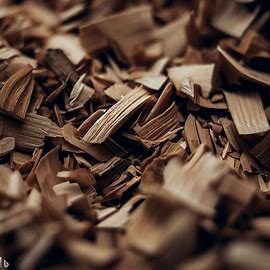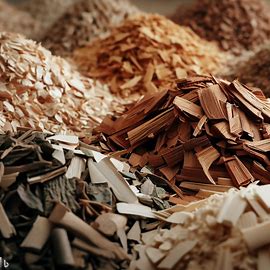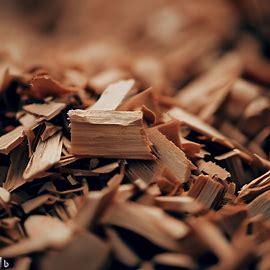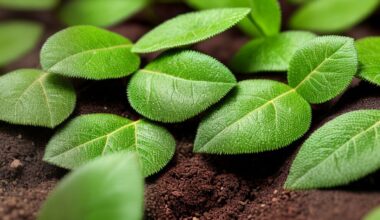Let’s face it, diving into a DIY landscaping project can be both exciting and intimidating. We all want that picturesque backyard or front garden which mirrors the ones we’ve drooled over in glossy home décor magazines.
But as you roll up your sleeves and get down to business, an intriguing query pops up – “just how much wood chip do I need?”
Surely, some of you must have pondered the same question during your own projects. It sounds pretty straightforward at first glance but as we delve deeper, it transforms into quite a perplexing riddle.
Join me now if you’re ready to unravel this mystery behind ‘the right amount’ once and for all! Prepare yourself for a thrilling revelation that may just make your next home improvement endeavor easier than ever before! Brace yourselves folks…it’s about to get seriously interesting!
Determining the Purpose for Wood Chips

When considering how much wood chip you need, it’s important to first determine the purpose of your project.
Are you planning on using wood chips as mulch in a garden?
Or perhaps you’re looking to use them for landscaping purposes.
Understanding the specific purpose will help guide your calculations and ensure you get the right amount.
Calculating Area of Coverage Needed
Once you’ve determined the purpose, it’s time to calculate the area of coverage needed. Measure out the length and width of your desired area in feet or meters. Multiply these two measurements together to find the total square footage or square meterage.
For example, if your garden measures 20 feet long and 10 feet wide, multiply 20 by 10 to get a total square footage of 200 square feet.
Importance of Layer Thickness in Quantity Estimation
After calculating the area of coverage needed, consider the thickness or depth at which you want to apply wood chips. The recommended thickness typically varies depending on their usage.
For most gardening projects, a layer between 3-4 inches is sufficient. However, if you are using wood chips for landscaping purposes such as creating paths or walkways, a thicker layer may be necessary for durability.
Using our previous example with an area measuring 200 square feet and aiming for a thickness of 3 inches:
Firstly convert inches into feet:
3 /12 = 0.25 ft
Then multiply this thickness by the total sqft:
0.25 ft * 200 sqft = 50 cubic feet
Therefore, when aiming for a layer thickness of 3 inches (or 0.25 ft), approximately 50 cubic feet of wood chips would be required.
Types of Wood Chips and Their Usage

Different types of wood chips serve various purposes, so it’s essential to consider which type is best suited for your project.
Common options include cedar, pine, hardwood, and cypress among others.
Each type has its unique characteristics such as aroma, color, and decay resistance.
For example, cedar wood chips are often used in gardens due to their natural pest-repellent properties and pleasant smell.
On the other hand, hardwood chips are commonly utilized in landscaping projects as they tend to break down slower than softer woods.
Consider the specific needs of your project before selecting the appropriate type of wood chip.
Impacts on Estimate: Moisture Content and Chip Size
Two factors that can affect your estimate when calculating how much wood chip you need are moisture content and chip size.
Moisture content refers to the water content present within the wood. Freshly chipped wood contains a higher moisture content compared to well-seasoned or aged mulch. This means that freshly chipped mulch will settle over time as it dries out.
When purchasing or estimating quantities for fresh chips versus seasoned ones can have an impact on your calculations.
Chip size also plays a role in determining how much volume is needed for coverage. Smaller-sized chips tend to compact more closely together compared to larger ones because they fill gaps between each other better.
Therefore if using larger-sized chips you may need more volume compared with smaller sizes when aiming for equivalent coverage areas.
Cost Considerations When Buying Wood Chips
Aside from estimating quantity requirements based on area measurements and layer thicknesses, it’s important to also consider cost implications when buying wood chips.
Bulk purchase options at local garden centers or nurseries typically provide significant cost savings compared to buying smaller bags individually.
However, do check delivery fees if applying bulk purchases for your project. Consider if the cost and logistics of obtaining bulk wood chips from a remote location outweigh the convenience sometimes offered by sourcing them locally, such as saving time and effort.
It may also be worth considering if there are any nearby tree trimming services or local arborists that offer free wood chips, which can help reduce costs further.
Local Availability and Delivery Options of Wood Chips

Finally, it’s essential to consider the availability of wood chips in your local area and delivery options.
Some regions may have more abundant supplies than others or different types available depending on regional vegetation patterns.
Additionally, enquire about the capabilities of delivery services; do they deliver directly to your property? Are there additional fees involved with this service?
By taking these factors into account along with your estimated quantity needs you’ll have a much better picture when making purchasing decisions for wood chip projects.
Conclusion
Determining how much wood chip you need involves several considerations including purpose, calculating coverage area, layer thicknesses, type of wood chip needed, impacts from moisture content, and chip size.
Cost implications should also be considered when buying in bulk versus smaller bags locally sourced.
Finally, assess availability and ensure you factor in delivery options as well. It is also important to conduct thorough research before making any purchases so that you can make an informed decision based on both convenience and budgetary considerations.






